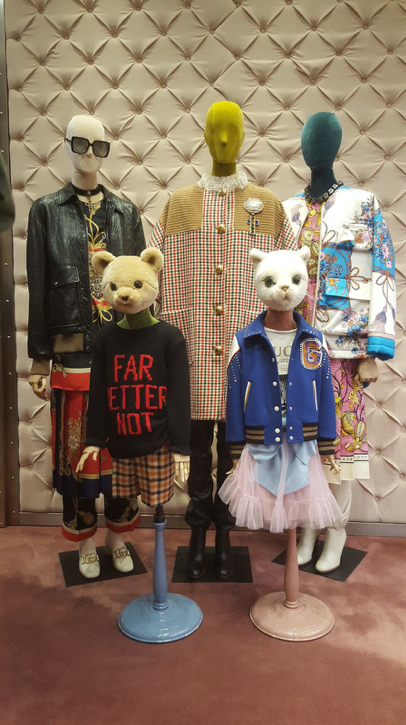
by Enoch Tsai, ’22
Fashion lies in a strange grey area in the realm of art. A case can be argued that on the runway, where models pose with avant garde clothing designed to showcase the minds of the fashion world, fashion is an art. But once an article of clothing is placed in a brick-and-mortar building with the intent of maximizing profits for a company, can it ever be considered a work of art? With this question in mind, I took advantage of this weekend to visit Rodeo Drive, one of the premier fashion shopping streets in the world. Home to boutiques such as Audemars Piguet, Saint Laurent, and Versace, Rodeo Drive would be a place, if nowhere else, that could potentially give insight on such a puzzling question.

The first thing that hits you when you enter the street are the cars. No not literally, although I would imagine getting hit by a Rolls Royce or Ferrari would get you a nice insurance claim and a fat check in your pocket. In fact, the streets are teeming with luxury cars of that caliber, and stepping out of them are the main money spenders on Rodeo Drive. International tourists with far too much money to spend, groups of wives with nothing else better to do on a Sunday afternoon, and college students with questionable financial decisions make up the crowd that spends nearly $15 million a year on this street- just in taxes. [2]
As I watched an 8 year old boy dressed in full Gucci convince his mother to buy a(nother) pair of Gucci slippers, the question of consumerism versus art surfaced immediately. In this high-end fashion world, buying a limited release of a specific clothing or jewelry could equate to purchasing a work of art from a museum. However, this is where the accessible nature of fashion tends to drag down its artistic value.

Unlike purchasing a Rembrandt, where you would have to search museums and collections for an opportunity to buy it, there are boys out here like the 8 year old I encountered today: covered from head to toe in Gucci. The collectors of what society considers “art” have an appreciation for whatever they are collecting; after all, they are investing countless hours and dollars into building a collection paintings and sculptures. Could this 8 year old really appreciate the history and designs of the clothing that he wore? In fact, this question could be applied to the majority of the shoppers on Rodeo Drive. Thousands of dollars are spent daily in Gucci boutique by people of all ages, yet during my visit, the Tom Ford boutique, home of the designer that brought Gucci into the fashion powerhouse it is today, barely had half of the shoppers that Gucci had.
This disconnect between shopper and brand is what I feel ultimately cheapens the idea of fashion as art. Art critics see the extravagant display of wealth and rush to buy the shiniest or newest item, and rightfully label that as fashion’s capitalistic grab at money and profits. However, during my time here at Rodeo Drive, I also encountered people genuinely invested in the brands and history behind them. At the Vacheron Constantin boutique, where watches regularly go for the price of a two-story house, we encountered people excited about the craftsmanship and artistry that went into the design behind every single watch. For them, buying the watch was more than a status symbol; they were buying the watch because of their love for the brand and what it stands for. After a couple hours of trying on clothes I had no business buying and getting berated by Prada employees for playing chess on a chess board in their store (apparently it was for decoration only), I stepped out into the real world with a better appreciation for the world of fashion. Fashion is far more than just buying expensive clothes and purses. Every single boutique invited me to explore the brand, to become immersed in the world that they could offer me. It is an experience, to find a label that speaks to you in its history and goal in fashion. It is just unfortunate that it becomes far too easy to misinterpret an opportunity to explore oneself through clothing as a chance to flex one’s wealth, especially on a street such as Rodeo Drive.

It shouldn’t be on the company to tell the world which collection should be considered art and which shouldn’t. Instead, it should be on us to find an appreciation for the artistry behind the label then perhaps fashion will no longer be under the capitalistic light it has been under for so long.
Sources:
We use cookies to improve your experience on our site. By using our site, you consent to cookies.
Websites store cookies to enhance functionality and personalise your experience. You can manage your preferences, but blocking some cookies may impact site performance and services.
Essential cookies enable basic functions and are necessary for the proper function of the website.
These cookies are needed for adding comments on this website.
Statistics cookies collect information anonymously. This information helps us understand how visitors use our website.
Google Analytics is a powerful tool that tracks and analyzes website traffic for informed marketing decisions.
Service URL: policies.google.com (opens in a new window)
Marketing cookies are used to follow visitors to websites. The intention is to show ads that are relevant and engaging to the individual user.